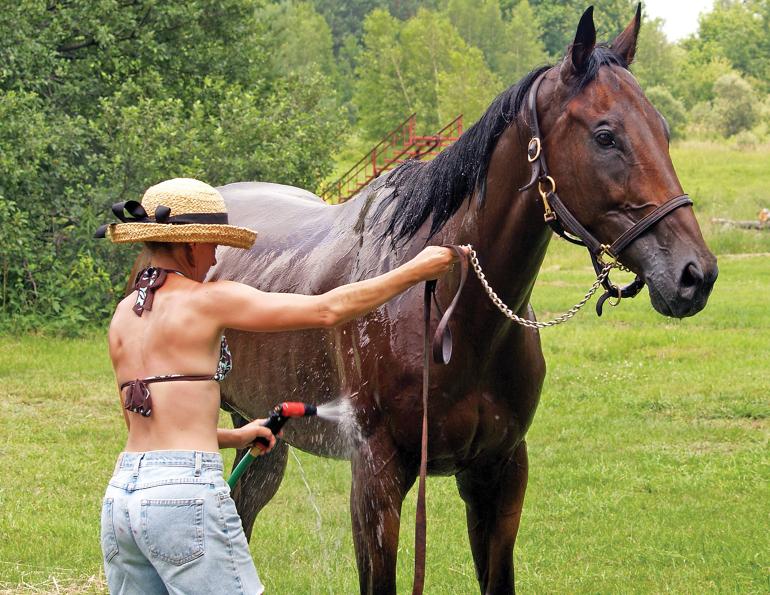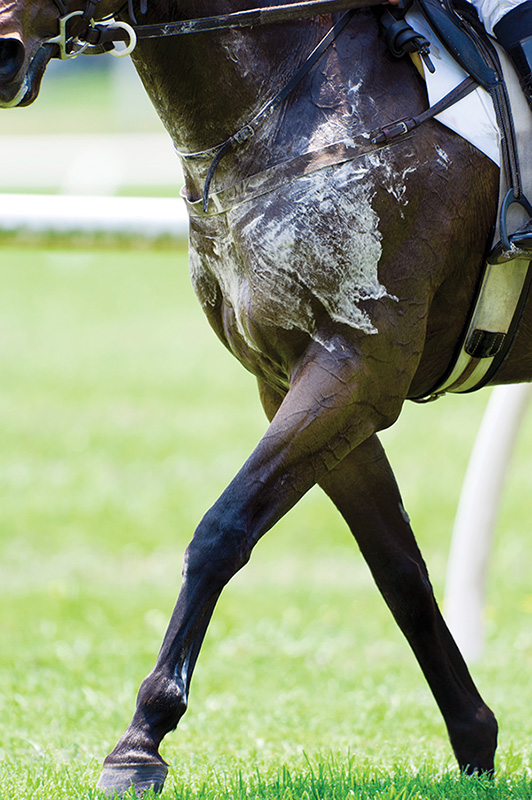
Dreamstime/Jason Mark Schulz
Is it hot enough for you?
If you feel suppressed by repeated days of hot and humid weather, you can be sure that your horse feels worse.
Horses have a much more difficult time maintaining their ideal core body temperature during hot humid conditions than humans do. This is due in part to their very high amount of contracting muscle in relation to the surface area that is available to get rid of the excess heat. Core body temperature of horses can increase at a rate of approximately one degree Celsius (C) per minute when exercising in hot, humid conditions. The major mechanism for cooling involves diverting blood flow away from internal organs — especially the gastrointestinal tract (GIT) — towards the skin, and production of large amounts of sweat on the skin, which cools the diverted blood via evaporation. When exercising in temperatures less than 28 degrees C (as measured by “wet-bulb globe temperature” which takes into account air temperature, humidity, wind velocity, and solar radiation), this is sufficient to lower core body temperature back down to the “ideal” level. However, at temperatures greater than 28 degrees C blood flow to the GIT is progressively reduced, which can lead to intestinal ischemia and development of leaky gut syndrome, colic, and/or death.

A horse’s water needs can be increased by ten times when they are exercised in hot, humid weather. Good hydration is essential to avoiding heat injury. Photo: iStock-1215350462 – MVBurling
As the core body temperature begins to climb, there is also a decline in blood flow to the brain, which increases permeability of the blood-brain barrier, resulting in incoordination, irritability, and sometimes dangerous erratic behaviour. The core body temperature at which these changes occur is debatable, but studies have suggested 42.5 degrees C in the blood and 45 degrees C in muscle. Note that changes in rectal temperature (i.e., the way most of us monitor core body temperature in horses) is the last place to increase in temperature, so your horse’s core body temperature is likely one or two degrees C higher than that measured on a rectal thermometer.
The most effective method for cooling an overheated horse is by repeated applications of cold (ideally ICE cold!) water in a shaded area. Water can conduct heat away from the skin at a rate 20 times greater than that of air at the same temperature and can hold up to 3500 times more heat per unit volume than air. Because of this, water can cool the body four times faster than using air of the same temperature. Contrary to popular belief that ice-cold water will cause vasoconstriction and actually slow down cooling, there is little evidence to support this. Exercising individuals who are overheated do not show the same vasoconstriction response to cold water as those who are at an ideal body temperature, and bringing the temperature down rapidly in an overheated horse is critical to avoiding serious heat injury.

Photo: iStock/Cmannphoto
Another essential strategy to avoid heat injury is maintaining good hydration, ideally through provision of water and electrolytes. Sedentary horses living in a moderate climate drink about five litres per 100 kg of body weight per day. When living in a cold climate, there is evidence that they prefer water at “room temperature” (approximately 20 degrees C) and tend to drink quite a bit less when the water is close to the freezing mark (around two degrees C). In the heat, however, they don’t seem to mind either way. Water demand can increase by ten times when horses are exercising in hot, humid conditions, and sometimes just offering water may not be enough. A dehydrated horse does not have the same thirst response as a human does, so including electrolytes in the water that is offered before and after exercise can help hold the water in the horse’s body (rather than being excreted by the kidneys).
What does this mean for your horse? Make sure your horse has access to clean, fresh water at all times. Electrolytes can be added to the water to improve hydration during exercise in hot, humid conditions. When exercising in the heat, consider working him or her during the cooler parts of the day (before 11am or after 6pm). Work horses on grass rather than sand when possible, as sand reflects solar radiation more than grass, and have shaded areas available. Use ice-cold water to cool down hot horses as rapidly as possible. And once your horse is nice and cool you might want to take a dip in a cold water trough yourself!
By Dr. Wendy Pearson, PhD (Dr. of Veterinary Toxicology) and http://www.horsejournals.com



